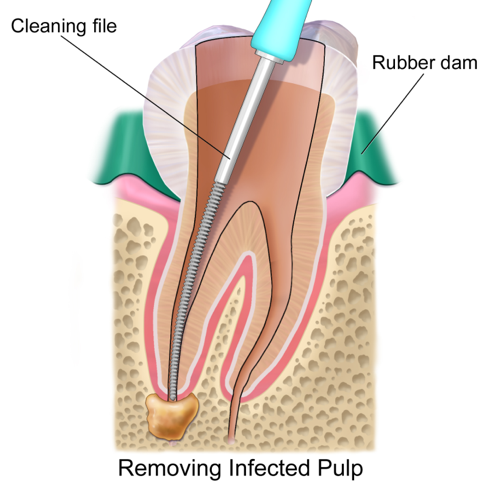Do you have questions about the process of getting a root canal? Did your dentist suggest that you have a root canal treatment/ therapy? First and foremost, root canal treatment is a fairly common dental procedure that occurs over 15 million times in the US. Moreover, all those root canals happen in a single year!
Let’s look at what a root canal is and why it might be necessary.
What is the Root Canal?
A root canal is a relatively easy and painless dental procedure similar to routine fillings. For starters, a root canal involves removing the infected or inflamed pulp (soft tissue in the center of every tooth). A general dentist then follows up the procedure by cleaning, disinfecting, filling, and sealing the teeth. That’s why the root canal also prevents the spread of infection across your entire mouth.

(Source)
What Makes a Root Canal Treatment Probable?
There are a whole lot of reasons that can cause your teeth pulp to manifest infections or inflammations. Some common causes that necessitate the proceeding of a root canal are as follows:
- Faulty crown placements
- Excessive Dental Surgeries/ Procedures on the teeth
- Chipped Tooth
- Injury to mouth (gums, teeth, etc.)
- Deep cavities (decays)
Moreover, that untreated pulp (i.e., infected) can lead to an abscess, which can become the source of agonizing oral pain! In contrast, a suitable endodontist can always help you save your natural teeth from infectious pulps and inflamed tissues. Meanwhile, in the US, there are over 148,000 general dentists among whom, approximately 4,400 are active endodontists.
The Root Canal Process
The procedure starts with a plastic wrap around your neck and a few hygienic practices. A dentist’s office is the prime location for such surgical procedures. So, let’s take a look at the entire root canal process in a step-by-step manner.
● First Step
Initially, your endodontist will place a numbing agent in your gum and the surrounding area of the affected teeth. You might feel a spiky burning sensation or a nip in your gum when your endodontist inserts a local anesthetic. It relieves and prevents pain during the entire root canal procedure.
● Second Step
After numbing the affected tooth, your endodontist will create a tiny incision at the top of the affected tooth. As soon the expose the infected and/or inflamed pulp to the open surface, special fiber tools will come into play. And so, the total removal of the infected pulp will occur.
Moreover, the special fiber tools feature precise cleaning of the pathways that lead into the soft tissue center of your affected tooth.
● Third Step
After completely removing the infected pulp, your endodontist will initiate the cleansing and disinfecting procedures. These procedures occur in your root canals via applying antibiotics. Eventually, this will prevent the spread of infection to other parts of your mouth.
Subsequently, your endodontist will fill the tooth canal with sealer paste while using a rubber dam to seal it. Antibiotic prescriptions then form the next order of the root canal procedure.
● Final Step
The fresh root canal can take damage from your saliva. Therefore, as the final step, your endodontist will apply a soft sealant to close off the tiny gap post-procedure.

(Source)
Post-Root Canal Procedure
Soreness and slight pain are common after-effects of undergoing a root canal process. However, in case of unusual and/or frequent pain, you should consult your general dentist or endodontist. Additionally, you will probably experience swelling in your gums. Therefore, your endodontist will always prescribe OTC medications to counter several pain symptoms.
After a root canal procedure, you will visit your endodontist frequently to let them take X-rays for a few days. They will do this to ensure that the infection is gone. Nevertheless, your normal routine might not start right away. Abstinence from crunchy, rigid, and sticky foods becomes critical.
Your endodontist may suggest adding permanent crown placements over your root canal tooth. However, it is totally up to you whether you opt for it. Though, artificial teeth (crowns) might help you maintain the pretty smiles while protecting your affected tooth from further damage.
Root Canal Process: Conclusion
Dig deep into the knowledge and studies regarding root canals. Despite the common misconceptions, you can always seek the best endodontist in your vicinity to carry out your root canal procedure(s).
At Bryant Park Endodontics in NYC, Dr. Young Bui operates as a premier Manhattan endodontist. He possesses a personal record of conducting over 15,000 root canals! Why? He utilizes the latest technology along with his skill and expertise to provide exclusive root canal treatments to his dental patients.
Give us a call at 646-205-3045 to schedule an appointment today. Or, you can visit our official website, here, for more information pertaining to Bryant Park Endodontics’s services and use of modern technology.
